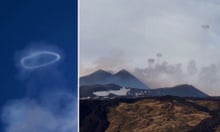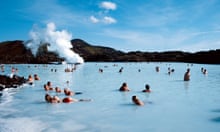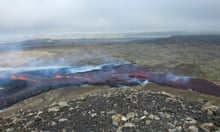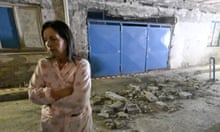On 19 September, after 50 years of magmatic quiescence, the Cumbre Vieja volcano on the Spanish island of La Palma roared back to life. Ash speckled the sky, and molten rock cooking at 1,075C (1,967F) oozed from several fresh fissures and cascaded down the volcano’s western flanks in the form of hadean rivers, ploughing through houses and farms with insouciance. Fortunately, thanks to the work of local scientists and emergency services, thousands of people were evacuated ahead of time, and no deaths have yet been reported.
So, what happens next? What new threats will emerge from the volcano? How long will this go on for? And why would anyone want to live in the shadow of such a menacing volcano in the first place?
How long is this eruption going to go on for?
That’s incredibly difficult to say. It could suddenly stop in the next few days, or it could go on for months. The average length of an eruption on La Palma in the Canary Islands is a month, but volcanic eruptions are like cats: they all possess their own distinctive personalities, and the duration of their paroxysmal moods can vary wildly.
What are its hazards?
The primary hazard is the relentless flow of lava – it has already bulldozed through hundreds of homes on the southwestern corner of the island, and it will continue to do so as it crawls its way towards the coast. The ash, too, is a problem: it’s not great to breathe in, especially if you have a pre-existing respiratory condition; it also creates visibility problems, burns out electric circuits, kills off car engines, pollutes waterways and smothers crops. A more insidious danger comes courtesy of the density of volcanic ash: the weight of accumulated ash on rooftops can cause them to collapse.
The eruption has become more explosive as of late. I’ve heard that this could cause a landslide and, in turn, a dangerous tsunami. Should I head for higher ground?
Volcanologists are concerned about the flanks of unstable volcanoes tumbling into the sea, which can and have triggered destructive tsunamis. A speculative paper from 2001, which formed the basis of an uncritical and sensationalist documentary, suggested the catastrophic collapse of the Cumbre Vieja volcano could cause a tsunami that would drown America’s eastern seaboard in waves up to 25 metres (82ft) high.
But that paper has since been widely debunked; scientists consider such a dramatic flank collapse as almost impossible. Not only is Cumbre Vieja structurally stable, but to get a flank collapse of any kind you would need a colossal volcanic explosion to coincide with a remarkably powerful earthquake – a confluence considered so unlikely to happen that it’s not worth considering. Even if the geologic gods were feeling especially grumpy and willed it to happen, the flank collapse would not produce anything close to that apocalyptic tsunami.
Will the lava do anything dangerous if it reaches the ocean?
Only if you’re standing nearby. When hot lava meets seawater it quenches, creating a plume of hydrochloric acid, glassy ash and steam – a decidedly problematic concoction. You can also get minor explosions if the magma wraps up and violently cooks seawater, which can jettison volcanic debris into the air. But these are highly localised threats, so staying clear of the ocean entry point will ensure you are out of harm’s way.
Are there likely to be further eruptions in the Canaries? I’ve got a holiday booked!
Not really. Volcanoes aren’t like bombs: they don’t set one another off, even if they are somewhat nearby. If there was another eruption on a nearby island, it would be a remarkable and improbable coincidence.
One possible issue for those looking to vacation in the Canaries, though, is the ash cloud coming out of Cumbre Vieja. This has already led to the closure of La Palma’s airport – and there is a risk that if the ash drifts across to other islands, their airports may be forced to temporarily close too.
Why do people even live near volcanoes?
About 800 million people live within 62 miles of an active volcano – one that, crudely put, has the potential to erupt at some point, in some fashion, in the present. Such living conditions may sound strange to people growing up in Britain, free of active volcanoes, but sometimes it is a choice. Volcanoes provide myriad benefits: fertile soil, a nexus for paying tourists, aesthetic beauty, spiritual or cultural importance and so on.
There can, however, be grim historical or socioeconomic reasons why settlements originally emerged on the slopes of volcanoes: sometimes you’ll find poorer, more marginalised communities living closer to the most dangerous parts of the volcano because those people are the descendants of slaves who worked on plantations, or because this hazardous land is cheaper.
The short answer, though, is that people live on or around volcanoes because that’s their home, and it always has been. The once-in-a-lifetime risk of a volcano erupting and killing them or destroying their home may seem like a strange risk to accept. But you could also wonder why anyone would live in Florida, which gets battered each year by increasingly intense hurricanes, or why anyone would live in the cities atop California’s soon-to-snap San Andreas fault.
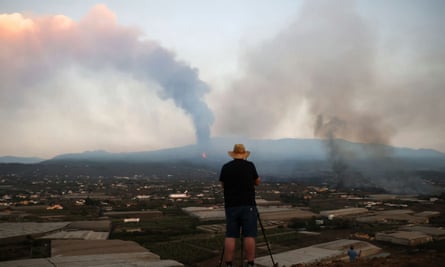
Are we getting better at forecasting volcanic eruptions?
No one can say exactly when and how a volcano will erupt. But scientists can detect signs of volcanic unrest in advance. This requires generations of accumulated scientific and cultural knowledge about a specific volcano, especially regarding what the volcano is usually like when it isn’t erupting. If that volcano is monitored by a suite of monitoring equipment – seismometers, gas-sniffing instruments, GPS sensors to measure ground deformation, satellites, drones and so on – then any dramatic changes from the volcano’s background behaviour can be flagged, and an alert signalling a possible near-future eruption can be made.
The eruption of the Cumbre Vieja volcano, for example, was forecast ahead of time. Scientists noticed the ground around the volcano was inflating and heard a seismic cacophony both indicative of magma breaking through rock and pushing its way to shallow depths. Although not willing to declare an eruption was imminent, partly because most magmatic intrusions fail to break through to the surface, volcanologists sounded the alarm, and the authorities began to evacuate the area before the lava ultimately emerged.
A similar eruption forecast was made in April at the La Soufrière volcano on the Caribbean island of St Vincent. Volcanologists, watching the mountain convulse and belch noxious fumes, suspected an explosion was brewing. They convinced the authorities to order an evacuation the day before that explosion arrived, saving hundreds of lives in the process.
Any tips for where a volcano might erupt next?
There are between 20 and 40 volcanoes erupting on any given day all over the world. It would be far stranger if no volcanoes were erupting. The Earth has a healthy geologic heartbeat, and erupting volcanoes are its way of cooling itself off while making new land in the process. These often beguiling, beautiful mountains of incandescent fury are the price we pay and the privilege we are granted of calling this world – a paradisiacal isle in an unforgiving starry ocean – our home.
Robin George Andrews’s book Super Volcanoes is published on 19 November by WW Norton & Co (£19.99)


